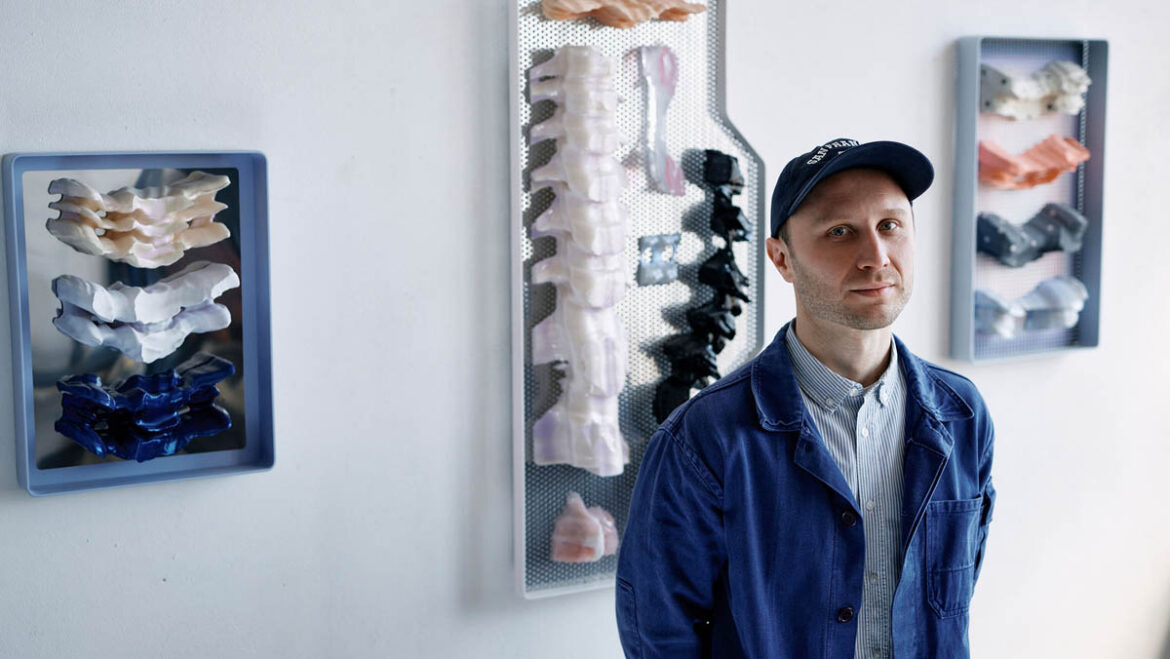
In mehrschichtigen Kombinationen aus pigmentiertem Epoxidharz, XPS und Stahl entfaltet der Künstler seine facettenreiche Material- und Farbpalette: knochenähnliche Strukturen mit samtigen Oberflächen, pastellfarbenen oder tiefschwarzen, zähflüssig wirkenden Hochglanzlegierungen werfen die Frage auf: Wer oder was wird in diesem Self-Healing Process eigentlich geheilt? Ist dies alles ein Ersatzteillager für einen Körper der Zukunft und damit die Aussicht auf Heilung zum Greifen nahe?
In Florian Appelts Installation Black Hole Sun wird Silizium – jener Stoff, der sowohl für den Knochenaufbau als auch für die Mikrochip-Technologie unverzichtbar ist – zu einem Medium, das nicht nur auf physischer Ebene, sondern darüber hinaus metaphysisch verbindet. Fast scheint es, als flüstere das Objekt ein digitales Mantra: „Ich bin der Ursprung. Ich bin das Ende.“ Die Inszenierung erinnert an einen sakralen Raum, das Objekt an ein Portal zu einer Zukunft, in der oberflächliche Optimierungen längst nicht mehr ausreichen. Black Hole Sun verweist auf die Notwendigkeit einer inneren Transformation, um kommenden Herausforderungen begegnen zu können.

Self-Healing Process wird zu einem Spiegel unserer Ambivalenzen angesichts der Herausforderungen des 21. Jahrhunderts. Die voranschreitende Verschmelzung – der Mensch wird zur Erweiterung der Maschine, und die Maschine erscheint dabei nicht weniger menschlich – entfaltet ein Unbehagen, das sich, ähnlich wie Florian Appelts Klangintervention, subtil über die versammelten Werke legt. Mit einer ästhetischen Präzision, wie sie sonst nur im High-End-Produktdesign zum Einsatz kommt, rückt der Künstler im Bildraum 07 die Auseinandersetzung mit der bereits begonnenen Zukunft und ihren möglichen Erscheinungsformen in den Fokus seines Schaffens.
Ausstellung: Florian Appelt. Self Healing Process kuratiert von Esther Hladik
Ausstellungsdauer: 4. April – 22. Mai 2025
Eröffnung: Donnerstag, 3. April, 19 Uhr
Begrüßung: Esther Hladik, Bildrecht
Zum Werk: Paula Watzl, Parnass
Adresse und Kontakt:
Bildraum 07, Burggasse 7-9, Wien 7
Öffnungszeiten: Di-Fr: 13 – 18 Uhr
www.bildrecht.at/bildraum/
Florian Appelt, *1992 in Wien studierte Bildende Kunst (Grafik und Druckgrafik) von 2013 – 2018, es folgte ein Doktoratsstudium mit dem Schwerpunkt Digitale Medien von 2018 – 2023 an der Universität für angewandte Kunst in Wien. Seine Arbeiten wurden in nationalen sowie internationalen Gruppen und Solo-Ausstellungen in Europa, darunter Stockholm, Berlin und den Niederlanden gezeigt. www.appeltflorian.com, www.instagram.com/florian_appelt/




